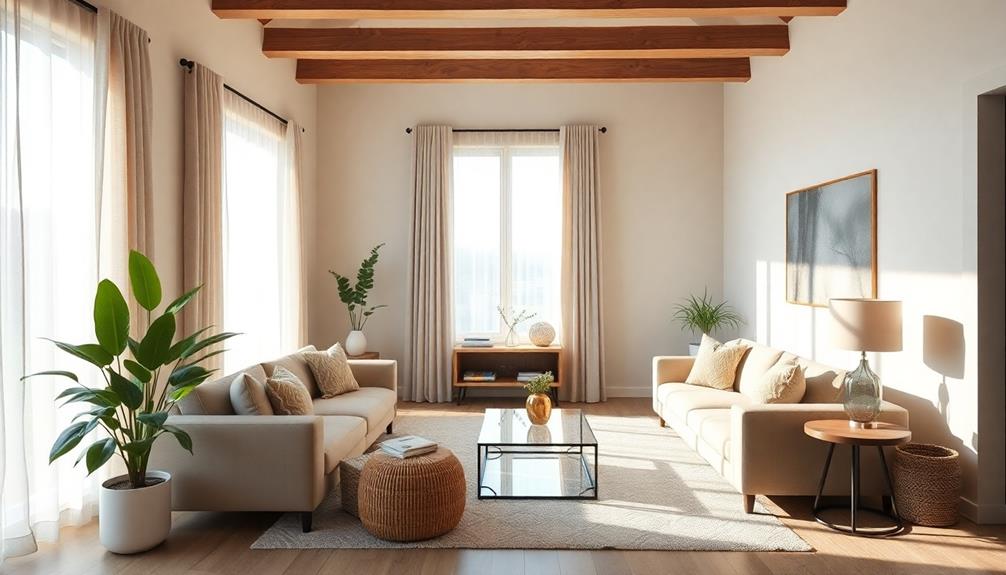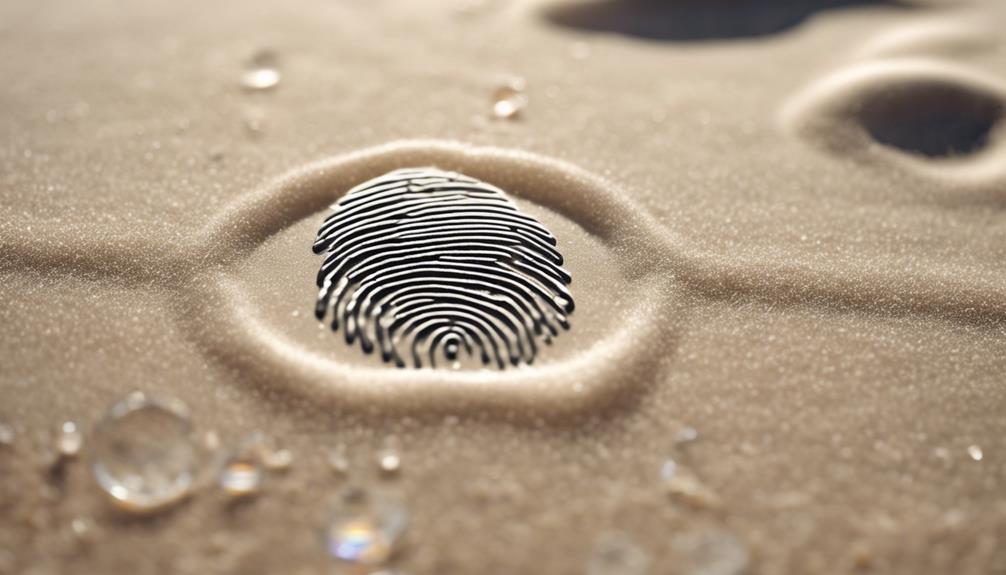Batik patterns can bring balance and harmony to your home by incorporating vibrant colors and intricate designs inspired by nature and culture. These textiles not only enhance visual interest but also carry deep cultural symbolism, like the Kawung motif, which promotes stability. To achieve a harmonious look, you can follow the 60-30-10 color rule, mix bold batik patterns with solid colors, and layer different textures. This combination creates a cohesive, inviting space that reflects a rich heritage. Discover more about infusing your home with the storytelling power of batik, and see how it can transform your living environment.
Key Takeaways
- Incorporate batik patterns using the 60-30-10 color rule to achieve a harmonious color balance in your decor.
- Utilize repetition of batik motifs throughout the space to create a sense of unity and rhythmic flow.
- Mix bold batik patterns with solid colors to maintain a cohesive design and prevent visual clutter.
- Layer batik textiles with contrasting textures to add dimensionality and depth to your living environment.
- Choose batik designs with cultural significance, promoting tranquility and fostering a deeper connection to heritage.
Historical Significance of Batik
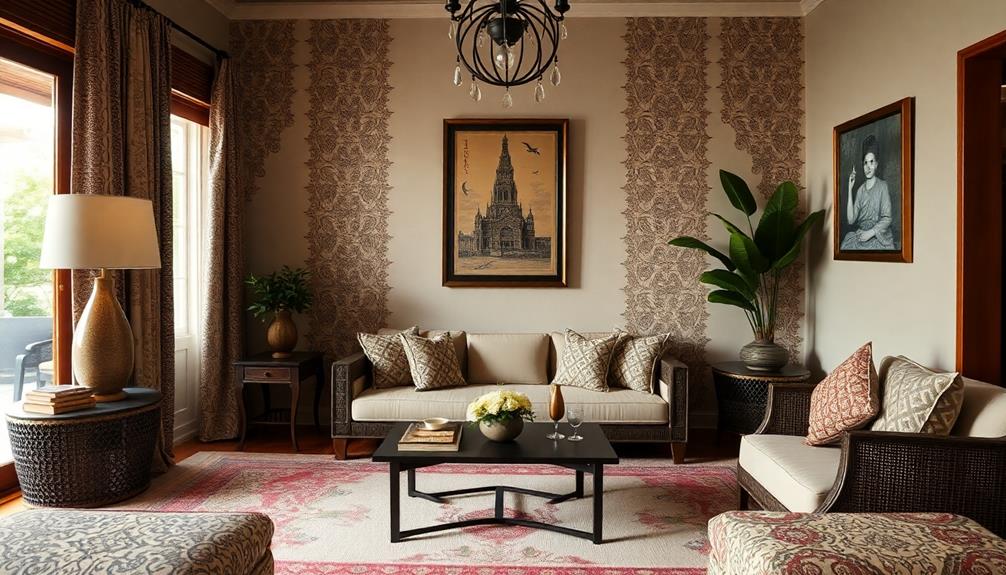
Batik, with its rich history and intricate designs, has woven itself into the cultural fabric of Indonesia for over 2,000 years. This traditional textile art originated on the island of Java, evolving through time and reflecting the diverse influences of Indigenous, Indian, Chinese, and European cultures.
The word "batik" derives from the Javanese term "ambatik," meaning cloth with little dots, which perfectly captures the meticulous process behind its intricate patterns. These designs often mirror the vibrant artistry seen in Indonesian decor masks, showcasing the same cultural richness and storytelling tradition.
Historically, batik held immense significance in Indonesian culture. It served not only as a form of artistic expression but also as a medium for conveying symbolic meanings. Often associated with nobility, batik was prominently used in royal courts, signifying status and prestige.
In 2009, UNESCO recognized batik as a Masterpiece of Oral and Intangible Heritage, underscoring its cultural heritage and importance.
As you explore batik patterns for your home, remember their historical significance. Each piece tells a story of evolution, tradition, and the rich tapestry of Indonesian culture, allowing you to bring a sense of history and harmony into your living space.
The Batik Creation Process
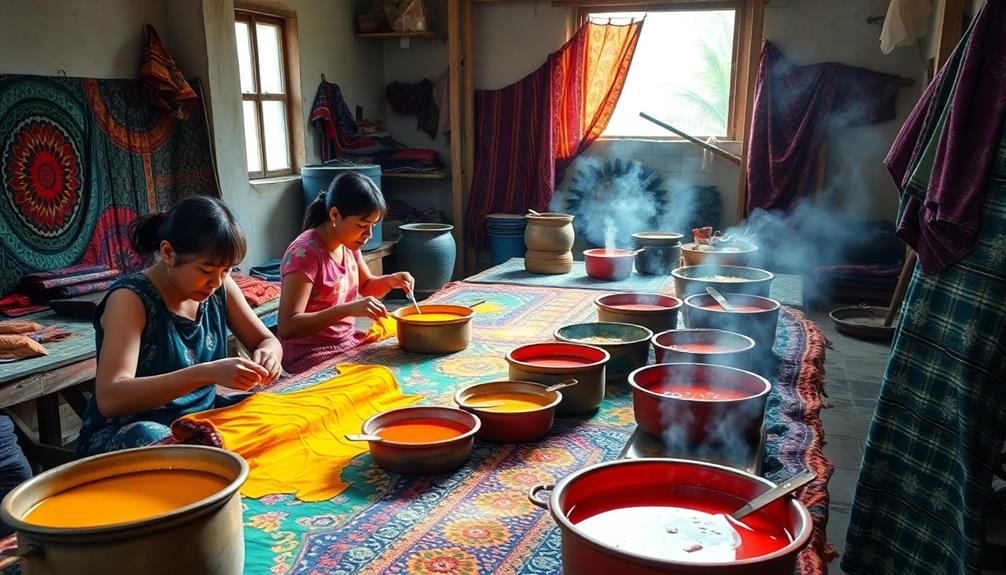
When you explore the batik creation process, you'll notice the essential materials and tools that make it all possible.
The use of vibrant colors and intricate patterns, often inspired by nature and cultural motifs, enhances the overall aesthetic appeal of the fabric, making it a versatile choice for various interior styles.
Each step, from applying hot wax to dyeing the fabric, plays a significant role in shaping the final design.
You'll also discover how the patterns convey deep symbolism, adding a personal touch to your home decor, as these textiles can beautifully complement Indonesian Decorative Pillows.
Materials and Tools Used
To create stunning batik patterns, you'll need a few essential materials and tools that play an important role in the process.
Start with batik fabric, typically made from natural fibers like cotton or silk, which you should pre-wash to enhance dye absorption and guarantee vibrant colors.
The canting tool is vital; this small, handheld device allows you to apply hot wax with precision, helping you create intricate patterns and designs on the fabric. The beauty of batik lies in its ability to reflect cultural heritage, similar to the vibrant Indonesian decor masks that showcase intricate craftsmanship.
Once you've applied the hot wax, dip the fabric into dye baths. The unwaxed areas will absorb the dye, creating a beautiful contrast with the waxed sections.
This is where the wax acts as a resist, keeping certain areas free from color. To achieve different effects, you can repeat the dyeing and waxing processes multiple times, layering colors and patterns that tell unique stories.
Step-by-Step Technique
Start by selecting your fabric, ensuring it's a plain natural fiber like cotton or silk that's been pre-washed for best dye absorption. This step is essential in the batik creation process, as it sets the stage for vibrant colors.
Incorporating elements of cultural artistry, such as Indonesian decor masks, can further enhance the overall aesthetic.
Next, using a canting, apply hot wax to the fabric. This wax acts as a resist, allowing you to create intricate designs while preventing dye from penetrating those areas.
Once you've completed the waxing process, immerse the fabric in a dyebath. The unwaxed sections will absorb the dye, resulting in stunning batik patterns that bring harmony to your home decor.
After dyeing, heat the fabric to remove the wax, revealing your carefully preserved designs.
Don't forget to wash the fabric afterward to eliminate any excess dye. This technique can be repeated multiple times with different waxes and dyes to create complex, layered patterns, showcasing the beauty of textile art.
Symbolism in Design
Batik's intricate designs are more than just visually appealing; they're steeped in rich symbolism that reflects cultural heritage and beliefs. When you explore batik, you'll discover that each pattern carries specific meanings tied to traditional customs. For instance, the Parang pattern symbolizes power and protection, while the Kawung pattern represents fertility and prosperity.
This profound symbolism can beautifully complement Balinese interior design concepts, where natural materials and earth tones create a calming environment natural materials and earth tones.
The batik creation process begins with applying hot wax to fabric using a canting tool, allowing for complex designs that resist dye absorption. This meticulous layering not only creates visual interest but also enhances the symbolism embedded in the final patterns.
As you admire these designs, you'll notice how the wax removal reveals vibrant colors, emphasizing the dynamic interplay of light and shadow.
Every piece of batik serves as a narrative, connecting you to your cultural roots. This art form incorporates spiritual and historical elements, making it a powerful medium for storytelling.
Cultural Patterns and Meanings
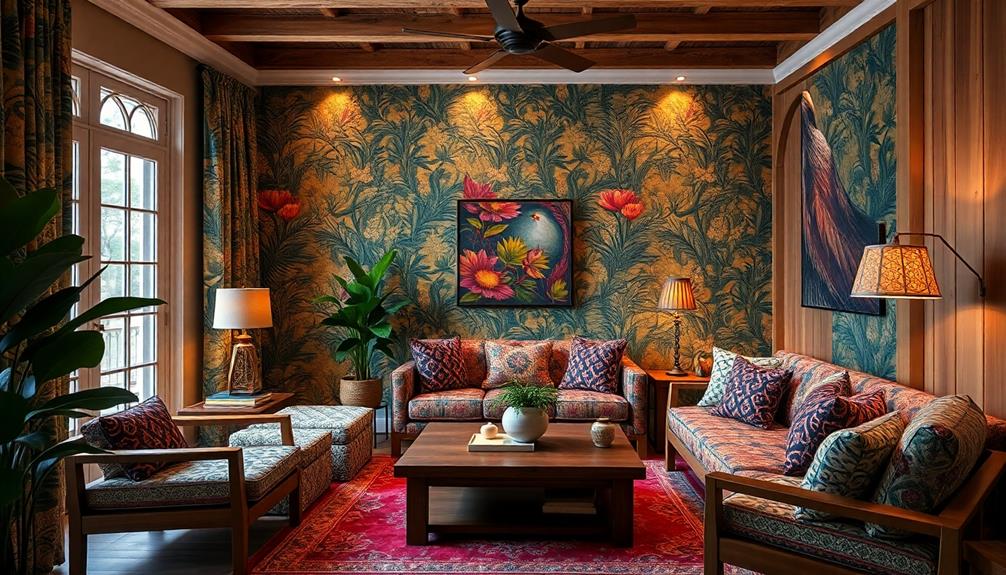
Many people mightn't realize that batik patterns are rich with cultural significance, each telling a unique story. These designs not only enhance your decor but also create emotional connections that resonate with the values and traditions of Indonesian batik.
Traditional Indonesian Style Home Decor beautifully integrates these patterns to further elevate the aesthetic appeal of your home. Here are four key motifs to reflect on:
- Kawung Motif: Symbolizes balance and stability, fostering a harmonious environment.
- Wahyu Tumurun Pattern: Represents divine blessing and enlightenment, infusing positivity into your space.
- Parang Rusak Motif: Denotes strength and royalty, enhancing the visual impact of any room.
- Udan Liris Motif: Associated with fertility and life, it evokes feelings of hope and abundance.
Incorporating these batik patterns allows you to weave cultural narratives into your home, enriching it with wisdom from traditional ceremonies.
Each motif contributes to a sense of dignity and presence, promoting balance and harmony in your living space. By choosing batik designs, you're not just decorating; you're embracing a legacy that deepens your appreciation for diverse cultures while creating an inviting atmosphere.
Batik in Home Decor

Incorporating batik into your home decor offers a vibrant aesthetic that instantly brightens your space.
These unique patterns not only enhance the visual appeal but also carry cultural symbolism that can create a sense of harmony.
By choosing batik textiles, you're embracing both artistic beauty and meaningful tradition in your surroundings.
Additionally, integrating batik pieces complements the serene and inviting spaces often created by experts in luxury tropical design.
This blend of traditional patterns with modern aesthetics can elevate your interior while celebrating local craftsmanship.
Vibrant Textile Aesthetics
With its vibrant colors and intricate patterns, batik fabric transforms any space into a work of art. By incorporating batik into your home decor, you can elevate your aesthetic while embracing cultural richness.
Indonesian Wedding Decor often features batik, showcasing its versatility and beauty. Here are four ways to make batik an integral part of your design:
- Curtains: Brighten your room with batik curtains that add visual interest and texture.
- Pillow Covers: Use batik-patterned pillow covers to create a cozy and inviting atmosphere.
- Tablecloths: Set the stage for memorable meals with beautiful batik tablecloths that spark conversation.
- Wall Hangings: Adorn your walls with batik art pieces that showcase traditional craftsmanship.
Batik patterns not only enhance the beauty of your space but also create balance and harmony through their unique designs. The vibrant colors and intricate motifs draw the eye, serving as focal points that elevate the overall ambiance.
This artistic touch bridges modern aesthetics with cultural significance, making batik a versatile choice for any home. By thoughtfully integrating batik into your decor, you can achieve a harmonious environment that reflects both style and tradition.
Cultural Symbolism Integration
Integrating batik patterns into your home decor not only beautifies your space but also enriches it with cultural significance. These intricate designs, steeped in Indonesian culture, offer meaningful focal points that reflect deep-rooted values and traditions.
For instance, the Kawung motif symbolizes balance and stability, promoting harmony in your living areas, while the Parang pattern represents power and protection, adding strength to your environment. Additionally, incorporating batik patterns aligns with the cultural significance of housing, as it allows for the expression of regional identity and heritage.
Using batik fabric for curtains or upholstery seamlessly blends beauty and cultural symbolism, bridging traditional craftsmanship with contemporary design elements. You can create stunning contrasts that enhance your interior style, whether you lean towards minimalist or eclectic looks.
Incorporating batik-inspired artwork or decorative accents allows you to express your appreciation for cultural narratives, fostering a connection to history amidst modern settings.
With their versatility, batik patterns can complement various design styles while narrating stories that contribute to a more engaging living environment. By thoughtfully integrating these motifs into your home decor, you not only celebrate Indonesian culture but also cultivate a space that embodies harmony, beauty, and cultural richness.
Achieving Balance With Batik
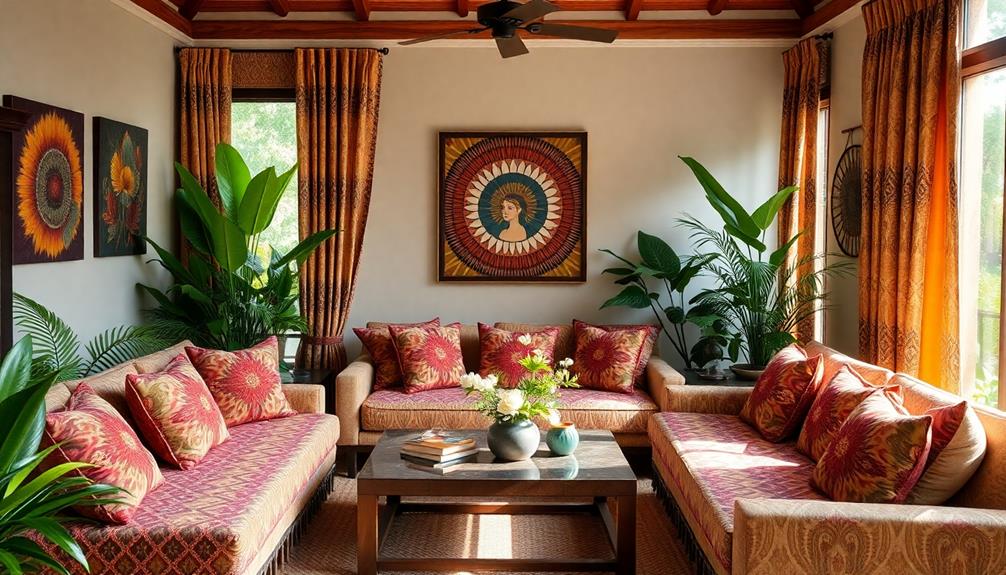
How can you achieve balance in your home decor using batik? By strategically incorporating batik patterns, you can create a harmonious and visually balanced space. Here are four effective ways to do it:
- Follow the 60-30-10 color rule: Use batik fabric as your accent color to enhance overall harmony. Consider exploring Indonesian wedding decor ideas that showcase the beauty of batik in vibrant color palettes.
- Repetition: Incorporate batik motifs in cushions, curtains, and wall hangings to establish unity and rhythmic flow.
- Cohesive design: Mix bold batik patterns with solid colors in large-scale applications, like tablecloths and upholstery, to prevent overwhelming visual clutter.
- Layering: Combine batik textiles with contrasting textures to add dimensionality, inviting exploration while maintaining balance.
The diverse range of batik patterns, such as the Kawung, symbolizes balance and stability, aligning with your personal and cultural aesthetics.
By thoughtfully layering these elements, you not only enhance visual balance but also create a dynamic environment that reflects tranquility and harmony.
Embrace the beauty of batik to transform your space into a cohesive haven that invites comfort and style.
Modern Interpretations of Batik
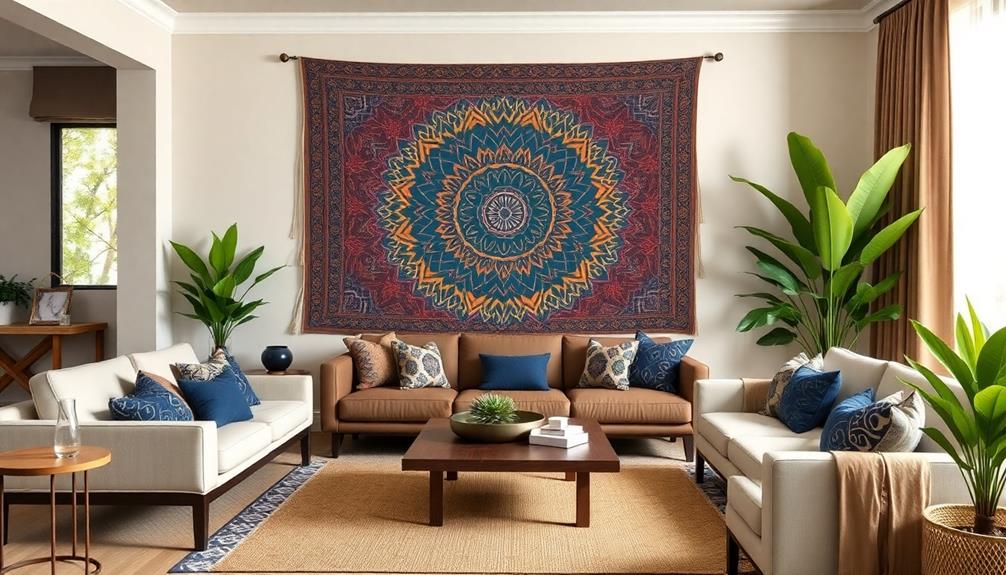
Batik has evolved considerably, embracing modern interpretations that resonate with today's aesthetic sensibilities. Designers are now blending traditional motifs with contemporary aesthetics, making batik patterns appealing to a younger audience and broadening their reach beyond cultural confines.
You can easily incorporate these modern interpretations of batik into your home decor items, like cushions, curtains, and wall art, creating a vibrant atmosphere that reflects your personal style while honoring cultural heritage.
The versatility of batik allows you to enhance various design styles, from minimalist to eclectic, fitting seamlessly into both traditional and modern interiors.
Many contemporary artists experiment with batik techniques on unconventional materials like canvas and wood, pushing the boundaries of artistic expression. This experimentation not only keeps batik relevant but also inspires new artistic movements.
Batik's rich colors and intricate patterns establish visual balance and harmony within a space, contributing to a cohesive design that invites warmth and creativity into your home.
Frequently Asked Questions
How Is Batik Used in Everyday Life?
You'll find batik in everyday life through clothing, accessories, and home decor. Its vibrant patterns enhance your wardrobe and living spaces, while also inspiring unique quilts and artwork that celebrate cultural heritage and creativity.
What Is the Importance of Batik Making?
Like a vibrant tapestry woven through history, batik making's importance lies in its cultural significance, storytelling, and community bonds. You connect with traditions, preserving heritage while expressing identity and values through intricate designs and shared artistry.
Why Is Batik so Special?
Batik's special because it blends history, artistry, and cultural significance. You'll appreciate its vibrant patterns, each telling a story, while adding unique charm to your space and connecting you to rich traditions and heritage.
How to Batik at Home?
To batik at home, gather natural fabric, wax, dyes, and a canting tool. Pre-wash your fabric, sketch your design, apply wax, dye it, and remove the wax to reveal your unique patterns. Enjoy experimenting!
Conclusion
Incorporating batik patterns into your home brings balance and harmony through vibrant colors and rich history. You create warmth with bold designs, you evoke tradition with intricate motifs, and you inspire creativity with unique textures. Whether it's in cushions, wall art, or curtains, batik transforms spaces into reflections of culture and personal style. So, embrace the beauty of batik, celebrate its stories, and let your home resonate with peace and creativity.



